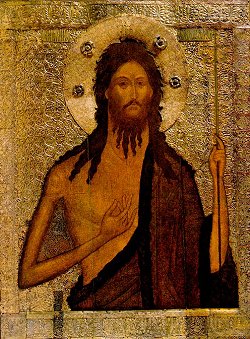
Moscow School, 1560s.
The State Museums of the Moscow Kremlin, 101 x 75 cm.

John the Baptist (Ioann Krestitel', Ioann Predtecha), the forerunner or precursor of Christ, forms a link between the Old and New Testaments. He is considered the last of the Old Testament prophets and the first of the saints of the New Testament,
where his story is told—a link between the two. John can be portrayed in several ways. The most common representation is of John as an adult, emaciated and unkempt, dressed in a robe of animal skin and holding a reed cross. This represents John's ascetic life spent in the wilderness. In some Western
representations, John the Baptist is accompanied by the inscription "Ecce Agnus Dei," which is derived from John (1:36), As [John] watched Jesus walk by he exclaimed, "Look, here is the Lamb of God" (NRSV). In a tradition originating in Byzantine art, John can be shown with angel's wings--as the Angel of the Desert--since both the saint and angels are messengers. The Beheading of St. John the Baptist is another possible Orthodox representation. John was imprisoned by Herod Antipas and later executed as a consequence of a promise made by the ruler to his step-daughter, Salome. In addition, Russian icons depict John the Baptist in the Deesis row, either as a full-length figure or as a bust-size image. In this icon John is portrayed in accord with the first description. He is seen with long hair and beard, dressed in a tunic of animal skin and holding a reed cross. The saint is depicted at half-length and in full face. The strong yet serene face, exposed torso, spindly arms and lean hands are painted with a smooth, yellow ochre. His tunic is a rich brown hue with incredible attention paid to achieve the semblance of texture. A silver-gilt stamped mounting covers the background as well as the margins. The darkness of John's features is complemented and offset by a filigree halo decorated with chased rosettes (Treasures from the Kremlin, 141).
This icon of John the Baptist displays certain characteristics typical of the Moscow school. John is painted in a warm palette and has slightly elongated features. Despite the elongated features, his appearance carries a realistic quality perhaps reflecting the Moscow school's naturalistic tendency of the late 16th century.
John the Baptist from the Annunciation Cathedral makes an interesting comparison to an early 6th century icon of John the Baptist from Sinai. The heavy outlining and bright colors seen in the Sinai
work are no longer apparent in the later icon, painted in warm palette characteristic of the Moscow school. Both representations of John the Baptist share the general icon characteristics of two-dimensionality, lack of natural source of light and shadow, and similar features. The icon from Sinai also displays two medallions of Mary and Christ in the upper left and right corners. The 16th century artist has chosen to leave this reference to the Deesis out of his representation of John the Baptist. [J.B.]
[Source: Treasures from the Kremlin].
